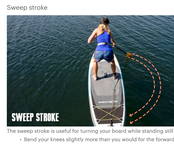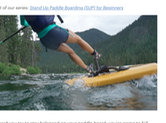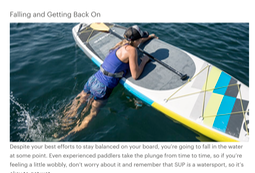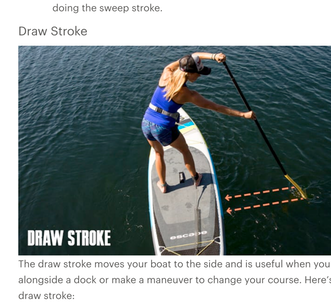DSC has two and generally kept in the Equipment room

Copied here from the REI CoOp are the paddling instructions KNOW BEFORE YOU GO.
Please click into their website for the FULL reading.
But you are training muscles, which need to be moving as the eyes and brain relate the instructions. Move on the beach not in your Screen & Chair please.
The following is similar to the CANOE Page here
Basically, like a canoe it is a LONG STRAIT FLOATING platform. You are pushing away at one corner. This ordinary paddle stroke on one side makes them go in a circle. So at the final end of each long stroke ending way behind you, turn the paddle outward and push sideways for 1 second. Or just use the “C” stroke. And watch Beckie Mason Solo Canoe
This is reaction making the back of the long craft slide into your course line behind the front. You are actually wiggling your way across the water.. More like going cornerwise. If the fin below was full length- it will resist going in circles. ( Of course, then you have a Sailboat Eh ?) OR you can just keep making two strokes on one side and swap the paddle over to the other side and make 2 strokes and repeat. BTY your long craft is still wiggling.

So Here from REI is the Step by Step :
How to Paddle a Paddle Board: Basic Strokes
A skilled stand up paddle boarder can glide gracefully across the water and maneuver every which way, all while appearing to barely break a sweat. If you’re new to SUP, you might be experiencing something entirely different; many beginner paddlers find themselves zigzagging across the lake and quickly growing tired.
With a few tips, you can learn to move the board just as you want and conserve energy while doing so. To set you on your way, here are several key SUP skills, including:
- How to size a SUP paddle
- How to hold a SUP paddle
- Essential SUP strokes

Video: Basic Stand Up Paddle Strokes
A skilled stand up paddle boarder can glide gracefully across the water and maneuver every which way, all while appearing to barely break a sweat. If you’re new to SUP, you might be experiencing something entirely different; many beginner paddlers find themselves zigzagging across the lake and quickly growing tired.
With a few tips, you can learn to move the board just as you want and conserve energy while doing so. To set you on your way, here are several key SUP skills, including:
- How to size a SUP paddle
- How to hold a SUP paddle
- Essential SUP strokes
Video: Basic Stand Up Paddle Strokes

How to Size a SUP Paddle
Before you head to the water, you need to be sure you’re using the right length paddle. A paddle that’s too long is cumbersome to use; one that is too short requires you to awkwardly hunch over to get the paddle into the water.
SUP paddles are available in fixed lengths or adjustable lengths. A fixed-length paddle tends to be lighter and stiffer, making it a good choice for long tours and races. An adjustable paddle lets you experiment with the length while you’re learning to SUP, and you can share the paddle with shorter or taller friends and family members. With either fixed- or adjustable-length paddles, make sure it's the right length by doing the following:
- Stand the paddle up vertically so the blade is touching the ground.
- Reach an arm up above your head and notice where it lands on the paddle.
- With a properly sized paddle, the T-grip handle will rest in the bend of your wrist.
Read our article, SUP Paddles: How to Choose, for more information on choosing and sizing a SUP paddle.
How to Hold a SUP Paddle
If there’s one sure way to spot a SUP newbie, it’s in how they hold the paddle. To help you dodge common errors, here are some tips:
- Blade angle: Hold the blade so it's angled forward from the shaft, not back.
- Hand position: Keep a light grip with one hand on the T-grip and the other on the shaft. Make sure your hands aren't too close together. (Read on for tips on finding the proper position.)
